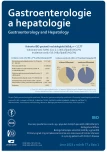Gastrointestinal dysfunctions and their influence on the quality of life in aging adults with spinal cord injury
Authors:
J. Štěpánová 1; P. Pliska 2; K. Raisová 1
Authors‘ workplace:
Katedra fyzioterapie, Fakulta tělesné kultury UP v Olomouci
1; IC Klinika Brno s. r. o., Brno
2
Published in:
Gastroent Hepatol 2023; 77(1): 38-42
Category:
Clinical and Experimental Gastroenterology: Original Article
doi:
https://doi.org/10.4895/ccgh202338
Overview
Background: People with spinal cord injury in the chronic stage of disability have several permanent health problems that get worse during aging. Among them, there are gastrointestinal complications, which have a significant negative impact on their quality of life. Objective: The purpose of this study was to evaluate the impact of the period since the incidence of the injury, level of spinal cord injury and Body Mass Index on the level of bowel dysfunction and on the quality of life of chronic patients. Method: Proceeding from a questionnaire-based survey, 42 adults with complete and incomplete spinal cord injuries completed the standardized questionnaire Neurogenic bowel dysfunction score (NBD Score), the standardized questionnaire Irritable Bowel Syndrome – Quality of Life survey (IBS-QOL) and non-standardized Czech version questionnaire Burwood Questionnaire. Results: A statistically significant positive linear correlation was evaluated between the period of time since the incidence of the injury and NBD score. The Pearson correlation coefficient was 0.6 (P = 0.02). However, there was no statistically significant linear correlation between the period of time since the incidence of the injury and value of IBS-QOL (–0.47; P = 0.47). Neither was there any statistically significant positive linear correlation with the variables the level of spinal cord injury and Body Mass Index. What most decrease the quality of life of disabled patients with gastrointestinal complications are concerns for their own health, depressive feelings, and diet routines. Conclusion: All medical staff should not neglect the need of diagnostic and therapy of the gastrointestinal problems in the aging subpopulation of people with spinal cord injury.
Keywords:
Quality of life – spinal cord injury – aging – neurogenic bowel dysfunction – questionnaire-based survey
Sources
1. Sauerbeck AD, Laws JL, Bandaru VV et al. Spinal cord injury causes chronic liver pathology in rats. J Neurotrauma 2015; 32 (3): 159–169. doi: 10.1089/neu.2014.3497.
2. White AR, Holmes GM. Investigating neurogenic bowel in experimental spinal cord injury: where to begin? Neural Regen Res 2019; 14 (2): 222–226. doi: 10.4103/1673-5374.244 779.
3. Holmes GM, Blanke EN. Gastrointestinal dysfunction after spinal cord injury. Exp Neurol 2019; 320: 113009. doi: 10.1016/j.expneurol. 2019.113009.
4. den Braber-Ymker M, Lammens M, van Putten MJ et al. The enteric nervous system and the musculature of the colon are altered in patients with spina bifida and spinal cord injury. Virchows Arch 2017; 470 (2): 175–184. doi: 10.1007/s00428-016-2060-4.
5. Lee JC, Gross BW, Rittenhouse KJ et al. A bitter pill to swallow: dysphagia in cervical spine injury. J Surg Res 2016; 201 (2): 388–393. doi: 10.1016/j.jss.2015.11.031.
6. Kříž, J. Poranění míchy: příčiny, důsledky, organizace péče. Praha: Galén 2019.
7. Posillico SE, Golob JF, Rinker AD et al. Bedside dysphagia screens in patients with traumatic cervical injuries: An ideal tool for an under-recognized problem. J Trauma Acute Care Surg 2018; 85 (4): 697–703. doi: 10.1097/TA.000000 0000002035.
8. Sogabe M, Okahisa T, Kimura T et al. Influence of metabolic syndrome on upper gastrointestinal disease. Clin J Gastroenterol 2016; 9 (4): 191–202. doi: 10.1007/s12328-016-0668-1.
9. Squair JW, Dhaliwal R, Cragg JJ et al. National Survey of Bladder and Gastrointestinal Dysfunction in People with Spinal Cord Injury. J Neurotrauma 2019; 36 (12): 2011–2019. doi: 10.1089/neu.2018.5967.
10. Weaver FM, Collins EG, Kurichi J et al. Prevalence of obesity and high blood pressure in veterans with spinal cord injuries and disorders: a retrospective review. Am J Phys Med Rehabil 2007; 86 (1): 22–29. doi: 10.1097/phm.0b0 13e31802b8937.
11. Harvey LA. Management of Spinal Cord Injuries, A Guide for Physioterapists. Londýn, Velká Británie: Churchill Livingstone, 2007.
12. Drossman DA, Patrick DL, Whitehead WE et al. Further validation of the IBS-QOL: a disease-specific quality-of-life questionnaire. Am J Gastroenterol 2000; 95 (4): 999–1007. doi: 10.1111/j.1572-0241.2000.01941.x.
13. Lynch AC, Antony A, Dobbs BR et al. Bowel dysfunction following spinal cord injury. Spinal Cord. 2001; 39 (4): 193–203. doi: 10.1038/sj.sc.3101119.
14. Rodriguez G, Cameron A. Neurogenic bowel dysfunction. In: Liao L, Madersbacher H. Neurourology. Heidelberg: Springer Netherlands 2019: 447–455. doi: 10.1007/978-94-017-7509-0_55.
15. Arnold EP, Losco G, English S et al. Symptoms of bowel dysfunction and their management after spinal cord injury in a New Zealand centre. N Z Med J 2018; 131 (1475): 21–26.
16. Johnson B. Physiology of the Autonomic Nervous System. In: Farag E, Argalious M, Tetzlaff J et al. Basic Sciences in Anesthesia. Springer International Publishing: 2018. doi: 10.1007/978-3-319-62067-1_19.
17. Gibbons CH. Basics of autonomic nervous system function. In: Clinical Neurophysiology: Basis and Technical Aspects. Elsevier 2019; 160: 407–418. doi: 10.1016/B978- 0-444-64032-1.00027-8.
18. Qi Z, Middleton JW, Malcolm A. Bowel Dysfunction in Spinal Cord Injury. Curr Gastroenterol Rep 2018; 20 (10): 47. doi: 10.1007/s1 1894-018-0655-4.
19. Al Dera H, Brock JA. Changes in sympathetic neurovascular function following spinal cord injury. Auton Neurosci 2018; 209: 25–36. doi: 10.1016/j.autneu.2017.02.003.
Labels
Paediatric gastroenterology Gastroenterology and hepatology SurgeryArticle was published in
Gastroenterology and Hepatology

2023 Issue 1
- Metamizole vs. Tramadol in Postoperative Analgesia
- Metamizole at a Glance and in Practice – Effective Non-Opioid Analgesic for All Ages
- Current Insights into the Antispasmodic and Analgesic Effects of Metamizole on the Gastrointestinal Tract
- Spasmolytic Effect of Metamizole
- Obstacle Called Vasospasm: Which Solution Is Most Effective in Microsurgery and How to Pharmacologically Assist It?
Most read in this issue
- Autoimmune hepatitis after vaccination against COVID-19
- Primary signet ring cell adenocarcinoma as a rare cause of colonic stenosis in a young patient with Crohn’s disease – the case report
- Gastrointestinal dysfunctions and their influence on the quality of life in aging adults with spinal cord injury
- Biological therapy of ulcerative colitis during pregnancy
